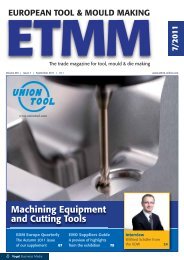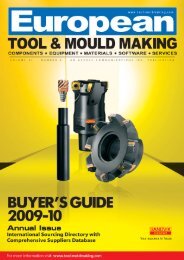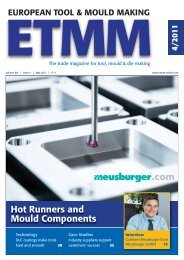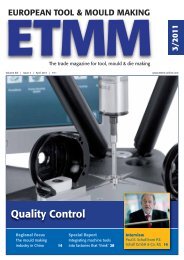Create successful ePaper yourself
Turn your PDF publications into a flip-book with our unique Google optimized e-Paper software.
Technology<br />
Synchronous Motors and Shaft Cooling Are Among<br />
Spindle System Innovations That Support Micromilling<br />
Steady progress in the miniaturization<br />
of industrial parts has made micromilling<br />
an ever more important manufacturing<br />
process. Medical devices, optical<br />
component housings, and EDM<br />
tooling are typical micromilling applications.<br />
To meet demanding performance<br />
expectations requires use of the<br />
right spindles. Thus, a new generation<br />
of micromilling spindles offered by<br />
Fischer AG Präzisionsspindeln sets<br />
improved market benchmarks for reliability,<br />
speed and precision.<br />
Synchronous Motors<br />
Whether a synchronous motor is to be<br />
preferred for an ultra-high-precision<br />
application depends on the outcome<br />
of an accurate analysis of specific application<br />
requirements. Both asynchronous<br />
and synchronous motors are<br />
very robust. However, improper parameterization<br />
of the converter system<br />
driving the spindle can cause a fatal<br />
error. Consideration of the total<br />
Axial growth of spindles with asynchronous and synchronous motors compared.<br />
mechatronic system (spindle including<br />
motor, plus converter) is crucial for<br />
ensuring that micromilling cutting requirements<br />
are met.<br />
Asynchronous motors offer high<br />
temperature resistance, but their permanent<br />
magnets demagnetize at operating<br />
temperatures above 150°C. This<br />
critically stresses the rotor band. Synchronous<br />
motors’ higher power density<br />
is a major advantage; having a<br />
greater centre bore results in better<br />
static stiffness and spindle dynamics.<br />
Disadvantages of synchronous motors<br />
18 European Tool & Mould Making ■ September 2009<br />
have been their smaller constantpower<br />
range and the mandatory inclusion<br />
of an encoder system. However, a<br />
major breakthrough by the Fischer<br />
Precise Group enables synchronous<br />
motors to be driven without an encoder.<br />
Thus, their benefits are available<br />
for micromilling applications.<br />
Owing to lower rotor temperatures,<br />
which lessens thermal axial growth of<br />
the spindle shaft, spindles with synchronous<br />
motors achieve better toolcentre-point<br />
repeatability. While the<br />
influence of mechanical forces on<br />
axial growth remains constant regardless<br />
of the speed chosen, synchronous<br />
motors’ lower rotor temperatures do<br />
have a beneficial impact.<br />
Tests performed on a grease-lubricated<br />
100-mm-OD HSK-E25 spindle<br />
with a top speed of 50,000 rpm compared<br />
an asynchronous and a synchro-<br />
The Fischer shaft cooling system.<br />
nous motor in terms of their influence<br />
on spindle growth (see graph at left).<br />
Using a synchronous motor decreased<br />
spindle rotor temperature by about 20<br />
K, which resulted in turn in 14 μm less<br />
axial growth, or a reduction of 26%.<br />
Considering only thermal expansion<br />
(subtracting mechanical growth from<br />
total axial growth), synchronousmotor-originated<br />
spindle growth is<br />
only half that caused by an asynchronous<br />
motor.<br />
Shaft Cooling<br />
The temperature behaviour of spindles<br />
matters a great deal in micromilling<br />
applications. Not only the temperature<br />
but the saturation time has to be minimized.<br />
<strong>Here</strong>, Fischer’s shaft cooling<br />
system (image at top) sets a standard.<br />
The complete shaft, including rotor<br />
and bearing inner rings, is cooled with<br />
water flowing through a series of channels<br />
and supplied via a special threechannel<br />
rotary joint that can also be<br />
configured as a regular rotary joint for<br />
sending coolant through the centre of<br />
the shaft to the tool tip.<br />
When such major heat sources as<br />
the rotor and bearings are cooled<br />
directly, tests show, up to 2 kW in losses<br />
from the spindle shaft can be eliminated.<br />
Consequently, spindle warm-up<br />
time is reduced by 80%, and less heat<br />
migrates into the machine.<br />
Fischer AG Präzisionsspindeln<br />
HERZOGENBUCHSEE, SWITZERLAND<br />
www.etmm.info/2009/09/029












